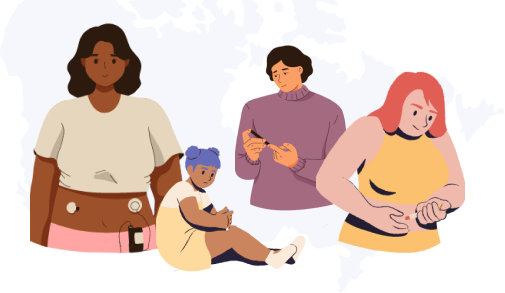When insulin was discovered in 1921, Canadian researchers sold the patent for a nominal $1 to the University of Toronto in the hopes of making this treatment accessible to all people living with diabetes. More than 100 years later, we’re far from this ideal in the U.S., where the price of insulin has skyrocketed.
A study published in 2022 observed that the price of insulin in the U.S. increased by 10.3% between 2016 and 2019 while it remained stable in Canada. In the U.S., pharmaceutical companies are free to set prices as they see fit while in Canada, the Patented Medicine Prices Review Board is mandated to regulate prices and prevent overpricing. However, the trend is changing as pharmaceutical companies, under pressure for the past few years, have just announced a drastic decrease in the cost of insulin.
Although insulin isn’t as expensive in Canada as it is south of the border, living with type 1 diabetes (T1D) still means having to deal with significant diabetes-related expenses on a regular basis.
Insulin is just the beginning
T1D entails several expenses, aside from insulin. There are costs related to the technologies used (e.g., blood glucose meter or CGM, insulin pump) and their supplies (e.g., insulin pen needles, blood glucose test strips, CGM sensors, infusion sets), treatments for hypoglycemia (e.g., Dex 4, gummies) and other types of diabetes-related care (e.g., consultation with a mental health professional).
While government insurance plans (e.g., RAMQ in Quebec, AHCIP in Alberta) help to reduce and sometimes largely eliminate out-of-pocket costs for people with T1D and their families, there are still many situations where they cover only a fraction of the costs.
A wide disparity in provincial drug insurance plans
Since 2001, Diabetes Canada has been reporting yearly on out-of-pocket costs for people with T1D. Their findings show that these costs vary significantly according to the province of residence, age, and type of treatment and medical devices used.
The reports highlight the disparities between Canadian provinces. In 2022, Alberta was the province with the lowest annual fee ($78) for youth with low family incomes ($30,000), regardless of treatment and medical devices used.
Conversely, the highest annual costs ($18,306) were shouldered by New Brunswick youth with high family incomes ($150,000) who used an insulin pump and a CGM.
This disparity is due to the different government plans, which cover anywhere from 0% to 99% of expenses, depending on the province.
A sizable chunk of the family income
According to the Senators Kirby and Keon’s report and the Romanow Commission on the Future of Health Care in Canada, out-of-pocket expenses that exceed 3% of the gross family income are considered significant.
Diabetes Canada’s 2022 report indicates that this is the case for more than half of Canadians living with T1D, with out-of-pocket expenses adding up to more than $3,100 per year.
Prince Edward Island and Quebec are the provinces where these costs represent the largest proportion of family income. Seniors with a low income ($30,000) who use an insulin pump and a CGM have no choice but to spend up to 20% of their income on diabetes-related costs.
While the report indicates that the coverage from government plans is higher for those with lower family incomes, it also stresses that the lower a family’s income is, the higher the proportion that they spend on diabetes-related expenses.
Reducing costs while improving the health of people with T1D
The report mentions many instances where the out-of-pocket costs are so high that they can lead people with T1D to make choices that could affect their health (e.g., not following physician recommendations, not choosing the best treatment).
This data is essential to show governments that measures should be implemented to reduce the cost of living with T1D and to improve access to care, treatment and technology.
The lack of knowledge about T1D extends to policymakers, affecting their ability to make good decisions. It is crucial to bring reliable figures to their attention.
Some of the research we’re conducting with data from the BETTER registry aims to establish the role that new therapies and technologies may have in improving and facilitating the management of T1D. However, accessibility and financial considerations remain a hurdle for many. One of our publications shows that even though Quebec is the province with the highest reimbursements, the risk of developing complications is higher among people with a lower socio-economic status.
The financial challenges associated with T1D have a significant impact on the daily lives of many people in Canada. While there is still a long way to go to reduce the financial burden caused by the unavoidable and necessary cost of living with diabetes, remember that since June 2022, the DTC (Disability Tax Credit) is now automatically available to all people with T1D in Canada.
Reference :
- Diabète Canada, Diabetes and Diabetes-Related Out-of-Pocket Costs, consulté le 21 février 2023, https://www.diabetes.ca/advocacy—policies/advocacy-reports/diabetes-and-diabetes-related-out-of-pocket-costs?utm_source=&utm_medium=banner&utm_campaign=campaign&utm_term=Text%20to%20give&utm_content=Learn%20more
- Schneider, Tyler et al. “Comparisons of Insulin Spending and Price Between Canada and the United States.” Mayo Clinic proceedings vol. 97,3 (2022): 573-578. doi:10.1016/j.mayocp.2021.11.028
- Rajkumar, S Vincent. “The High Cost of Insulin in the United States: An Urgent Call to Action.” Mayo Clinic proceedings vol. 95,1 (2020): 22-28. doi:10.1016/j.mayocp.2019.11.013
- Talbo, Meryem Khadija et al. “Associations Between Socioeconomic Status and Patient Experience With Type 1 Diabetes Management and Complications: Cross-sectional Analysis of a Cohort From Québec, Canada.” Canadian journal of diabetes vol. 46,6 (2022): 569-577. doi:10.1016/j.jcjd.2022.02.008

Written by:
- Sarah Haag RN. BSc.
Reviewed by:
- Amélie Roy-Fleming Dt.P., EAD, M.Sc.
- Rémi Rabasa-Lhoret, MD, Ph. D.
- Anne-Sophie Brazeau, Dt.P. PhD
- Claude Laforest, Jacques Pelletier, Aude Bandini, Michel Dostie, Marie-Christine Payette, patient partners of the project
Linguistic revision by: Marie-Christine Payette
Participate in the BETTER registry!

First registry of people living with T1D in Canada.
Learn More








